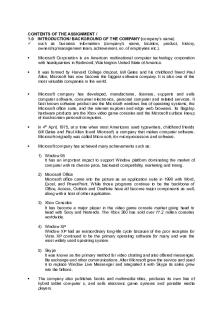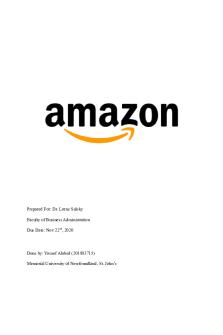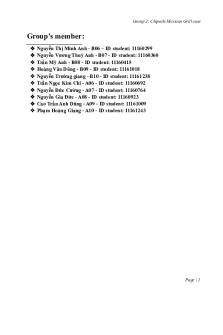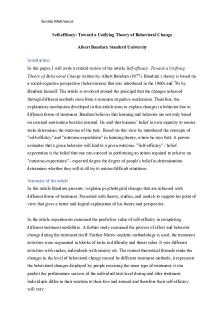MGT 162 INDIVIDUAL ASSIGNMENT PDF

| Title | MGT 162 INDIVIDUAL ASSIGNMENT |
|---|---|
| Author | Oliver Aaron |
| Course | Accounting |
| Institution | Universiti Teknologi MARA |
| Pages | 24 |
| File Size | 708.6 KB |
| File Type | |
| Total Downloads | 259 |
| Total Views | 482 |
Summary
UNIVERSITI TEKNOLOGI MARA CAWANGAN SABAHKAMPUS KOTA KINABALUnull(AC1101A2)DIPLOMA IN ACCOUNTANCY OCT 2020 – FEB 2021nullMGTINDIVIDUAL ASSIGNMENTTOPIC:ASIAN SUPPLY BASE SDN BHDnullPREPARED BY:OLIVER AARON JULINOH2020809688PREPARED FOR:MISS PRESANTIA BUJANGFACULTY OF BUSINESS AND MANAGEMENTUiTM CAWANG...
Description
UNIVERSITI TEKNOLOGI MARA CAWANGAN SABAH KAMPUS KOTA KINABALU
(AC1101A2) DIPLOMA IN ACCOUNTANCY OCT 2020 – FEB 2021
MGT162 INDIVIDUAL ASSIGNMENT TOPIC: ASIAN SUPPLY BASE SDN BHD
PREPARED BY: OLIVER AARON JULINOH 2020809688
PREPARED FOR: MISS PRESANTIA BUJANG FACULTY OF BUSINESS AND MANAGEMENT UiTM CAWANGAN SABAH, KAMPUS KOTA KINABALU
SUBMISSION DUE: 8 JANUARY 2021
ACKNOWLEDGEMENT First of all I would like to thank God for giving me the time and opportunity to complete and finish this project paper, despite all the obstacles and challenges especially during this pandemic time while doing this research. I would like to convey my love and appreciation to my family members who have given me unlimited moral support to me and always believe in what I am doing. I thank you for your support. I also would like to express the most honourable thanks to my lecturer, Miss Presantia Bujang for all her continuous guidance, guidelines and support along the research paper. Last but not least, I would also like to thank you to those who have contributed directly or indirectly in this project. Thank you to all of you.
2
DECLARATION FORM
3
TABLE OF CONTENTS
CONTENTS 1.0 INTRODUCTION
NO. PAGE 5
2.0 PLANNING
6-8
3.0 ORGANIZING
8-12
4.0 LEADING
13-14
5.0 CONTROLLING
15-16
6.0 CONCLUSION
16
7.0 REFERENCES
17-19
4
1.0 INTRODUCTION Asian Supply Base Sdn Bhd is a logistics business that is managed by Malaysians in the oil and gas industry. This supply base is strategically located in Malaysia’s second federal territory, that is the Federal Territory of Labuan, which is situated just off the Sabah coast. ASB was established and incorporated on 17th March 1984, several days before Labuan was gazetted as a federal territory. Labuan was chosen due to the Federal Government’s aspiration to turn Labuan into an oil and gas hub.Adding on, to provide employment in the oil and gas sector for the locals of Labuan and Sabah. In 1988, Asian Supply Base offered bulking facilities to their clients with the installation of a Dry Bulking Plant. In 1989, Petroliam Nasional Berhad (PETRONAS) Carigali Sdn Bhd (PCSB), founded by Tengku Razaleigh Hamzah, moved into ASB as the second Production Sharing Contract Company to occupy the base. ASB has a complete lineup of facilities and services. Their facilities include an all weather jetty, Quay Wharf and a dolphin jetty that can provide adequate berthing space for 14 supply boats at any one time. Additionally, there are flood lights placed strategically in the work area to provide clear overtness for night operations. ASB Maritime services specializes in the provision of marine transport and support services for its clients Asian Supply Base Board of Directors includes its chairman, YB Datuk Rozman bin Datuk Haji Isli ,who is the MP (member of parliament) for Labuan. He is followed by a total of six directors.The Board is supported by ASB’s management team headed by the CEO of ASB, Noor Halim bin Datuk Haji Zaini, supported by the CEO’s office and a total of nine heads of departments. (Welcome To Asian Supply Base, 2017)
5
2.0 PLANNING
2.1 VISION
“ To be globally recognised as an efficient and reliable supply base for the oil and gas industry” According to the Corporate Finance Institute (2020) vision is “what a company desires to achieve in the long-run.” A company’s vision statement gives an outlook of what the company would look like and would achieve in several years. Like most companies, Asian Supply Base also has a set of vision, mission, goals and objectives which can steer the company in the right direction in the logistical industry. They firmly believe that with their logistical expertise, tried and tested performance and years of experience can skyrocket them into the industry’s number one. Asian Supply Base vision statement reads, “To be globally recognised as an efficient and reliable supply base for the oil and gas industry”(Vision & Mission , 2016). 2.2 MISSION The Corporate Finance Institute, (2020) defines mission statement as “defines what line of business a company is in and what purpose it serves”. Asian Supply Base’s mission statement is to add value through providing efficient and cost effective service that is available 24 hours a day and 365 days of service, provide reliable and adequate equipment and facilities to further satisfy current and future business requirements, providing competent manpower, and provide services that meet clients’ expectations and requirements. Adding on, to provide services that comply with national and international standard operating procedures (SOP), provide services that comply with all relevant legal requirements of Health, Safety & Environment (HSE), and provide services that comply with ISPS Code.(Vision and Mission, 2016).
6
2.3 OPERATIONAL PLAN The definition of operational plan is, “plans that specify the details of how the overall goals are to be achieved” (Robbins & Coulter, 2002). In Asian Supply Base, there is a standing plan policy used by the company for day to day operations.
2.3.1 STANDING PLAN
a) Policy According to Robbins (2008d), a standing plan is “ongoing and provides guidance for repeatedly performed actions in an organization.” Safety is the top priority in ASB as this side of business involves handling of dangerous chemicals and petroleum. As part of their standing plan, Asian Supply Base has made a policy named the Quality, Health, Safety & Environment (QHSE) which needs to be obliged fully by ASB workers and management, in order to serve its clients’ efficiently with compliance to the highest safety standards. QHSE Policy Statement reads, that as it is ASB’s vision to be best in class through the provision of integrated logistic support and facilities and accommodations, ASB shall accommodate all base users with professionalism, courtesy, efficiency and reliability and ascertain sustainable development of human capital in the company. Additionally, ASB also embeds and enhances safe and salubrious working culture, safeguard assets, create a conducive and safe work environment in the base at all times to obviate loss, injury and ill-health in the supply base. ASB shall also monitor, ensure and to have in place control measures in order to mitigate significant environmental impacts to prevent pollution. ASB and continually reviews and improves its effectiveness, adequacy and suitability of Integrated Management System (IMS).( QHSE Integrated Policy Statement , 2016)
7
3.0 ORGANIZING According to Robbins & DeCenzo (2008), organizing is one of the four management processes. Organizing can be defined as “a process of determining what tasks are to be done,who is to do them, how the tasks are to be grouped,who reports to whom, and where decisions are to be made.”
3.1 ORGANIZATIONAL STRUCTURE Corporate Finance Institute (2020) defines organizational structure as “blueprints that reveal how companies are run and managed and how information is passed within the organization.” Asian Supply Base organizational structure consists of the following:
8
Diagram 1 : ASB’s Organizational Structure Source : Management Team (2016) 3.2 CHAIN OF COMMAND Chain of command is defined as “the continuous line of authority that extends from the highest levels in the organization to the lowest levels and clarifies who reports to whom.” (Robbins & DeCenzo, 2 008). The CEO of Asian Supply Base, Noor Halim bin Datuk Haji Zaini, is the top manager of the organization. The middle manager is in the CEO office and it includes Alice Wong, who is the Head of System Controls and Compliance and Bahari bin Zainal, who is the
9
Head of M&E/Base Development. The lower managers are the heads of nine departments in the organization. It includes, Razak bin Alli the Head of PMO & Corporate Planning, Donald Chin the Head of Finance, Mashkuri bin Harun the Head of Corporate QHSE, Idris bin Mohammad the Head of Corporate Services, David Agang Teo the SCM & Base Development, Cheng Guan Voon the Head of Infrastructure & Engineering, Zulainahwaty Sulaiman the Head of Human Resource, Marvin Chong the Head of Corporate Legal Services and Ker Boon Chong, the Head of Marine Service (Management Team , 2016). Asian Supply Base uses the unity of command principle where no person should report to more than one boss. The employees are the people who support the lower, middle and top level managers. For example, employees under the department of SCM & Base Development will need to report to the head of that department, and the head of department will report directly to the CEO of Asian Supply Base. 3.3 SPAN OF CONTROL The span of control in an organization refers to “the number of subordinates a manager can direct efficiently and effectively.” (Robbins & DeCenzo, 2008). In Asian Supply Base, the CEO, who is the top manager, maintains only a small span of control, that is, he only needs to control his subordinates in the CEO office that is the Head of System Controls & Compliance and the Head of M&E/Base Development. The middle managers, who are Alice Wong and Bahari bin Zainal, both heads of their respective departments need to cover a wide span of control, that is to control the nine departments. The nine heads of departments will have to also cover a wide span of control, that is to control employees under their respective departments. 3.4 LINE AND STAFF RESPONSIBILITIES Line authority refers to “the authority that entitles a manager to direct the work of an employee” (Robbins, 2008a). It is an employer-employee authority that extends from the top of the organization (the CEO), until the lowest (the Employees). As a link in the chain of command, a manager with line authority has the right to direct the work of employees and make decisions without the consultation of others. Line authority refers to managers who contribute directly to the organization’s objectives. In Asian Supply Base, the Line Authority here is the Chief Executive Officer of Asian Supply Base and all the head of departments, excluding the Human Resources Department. Due to the organization’s size, Asian Supply Base has its own staff
10
authority to support, assist, advise, and reduce some informational burdens of managers. Staff authority, in the context of management, refers to the employees who are not directly involved in achieving the company’s goals and objectives, but are more involved in administrative functions such as accounting. The staff authority in Asian Supply Base is the Human Resources Department. This department oversees the recruiting of new employees. 3.5 TYPES OF DEPARTMENTALIZATION Asian Supply Base adopts a network structure type of departmentalization, which follows grouping based on alliances with other organizations. Asian Supply Base has nine separate departments headed by a manager. The first department is, Department of PMO & Corporate Planning. The second department is, Department of Finance. The third department is the Department of Corporate QHSE. The fourth department is the Department of Corporate Services. The fifth department is the Department of SCM & Base Development. The sixth department is the Department of Infrastructure and Engineering. The seventh department is the Department of Human Resource. The eighth department is the Department of Corporate Legal Services, and the ninth department is the Department of Marine Services. 3.6 LOCUS OF DECISION MAKING Centralization and decentralization play a big part in an organization. Centralization means “a function of how much decision-making authority is pushed down to lower levels in an organization.” (Robbins & DeCenzo, 2 008) Decentralization means the pushing down of decision-making authority to the lowest levels of the organization.” (Robbins & DeCenzo, 2 008). In Asian Supply Base, decentralization of decision-making is made by the CEO to the nine heads of department. The heads of department, who are managers, have the power to make their own rational decisions in relation to their respective departments. The power of decision-making does have its limits though. For more important decisions that could impact the organization as a whole, such as acquisitions, are the type of decisions that the other departments have no say over. For important decisions, as the ones mentioned, the decision-making process is centralized in the CEO of Asian Supply Base, its offices and its Board of Directors. They will make the decisions based on what is best for the organization. The other departments can only advise them on such decisions.
11
3.7 DELEGATION According to Corporate Finance Institute (2018), delegation is “a process of transferring the authority for a specific activity or task to another member of the organization and giving power to that individual to accomplish the task effectively.” A manager has tons of work and assignments given to him, so to avoid being overwhelmed by the workload, he must delegate part of the work to his workforce/employees to ensure the task given can be finished effectively and to make sure all employees are involved in the process. In Asian Supply Base, the top manager (the CEO), delegates his work to the middle managers (the CEO offices), and the middle managers, granted with authority from the CEO, delegate their work to lower managers (the nine heads of departments). The lower managers would then delegate their work to their subordinates. Subordinates would then be held responsible for the tasks given and are monitored.
12
Diagram 2 : Delegation Structure of Asian Supply Base 4.0 LEADING Robbins & DeCenzo (2008) defines leading to be a process that “includes, motivating employees, directing the activities of others, selecting the most effective communication channel, and resolving conflicts.” Asian Supply Base adopts the Behavioral Theory which is the Michigan University Studies. 4.1 Behavioral Theory : The Michigan University Studies The Michigan University Studies (also known as the Michigan Leadership Studies) is a series of leadership studies conducted
by the University of Michigan in the 1950s to identify the
principles and types of leadership styles(Michigan Leadership Studies, 2021). The study found two basic types
of
leader
behaviours
which is production-focused behavior and
employee-focused behavior. The specific style that Asian Supply Base’s leaders use is employee-focused behaviour. According to the study, employee-centered behavior is when a leader focuses primarily on workers as human beings. The CEO of Asian Supply Base gives high concern to employees under his leadership. (Towards Transforming Asian Supply Base Labuan Into World Class O&G Service Provider - Pt.1, 2016) In Asian Supply Base, the CEO motivates his subordinates using the Maslow Hierarchy of needs theory to support his employee-centered behaviour leadership. The Maslow Hierarchy of Needs is developed by Abraham Maslow and suggests that there is a hierarchy of five human needs which is: physiological, safety, social esteem, and self-actualization (Robbins & DeCenzo, 2008). To fulfill the physiological needs of the employees, the CEO of Asian Supply Base offers a cafeteria in the supply base for employee usage and makes sure their salary is enough to enable them to buy their personal property. The safety needs of employees are fulfilled by introducing the QHSE Policy Statement, which ensures employee safety in the work area and also . For social needs, ASB has hosted Hari Raya celebrations, family days and other activities in order that the employees feel a sense of belonging and friendship in the company. As for esteem needs of the employee, ASB recognizes every employee's achievement by promoting them and increasing their salary. As for self-actualization needs, the CEO of Asian Supply Base guarantees
13
that the work environment is an opportunity for the employees to learn and develop themselves. In the words of the CEO himself, “A good working environment, good benefits, competitive salary and a great company culture are of paramount importance to the employees. This will lead to an innovative, creative and productive workforce.” (Towards Transforming Asian Supply Base Labuan Into World Class O&G Service Provider - Pt.1, 2016)
14
5.0 CONTROLLING According to Robbins & DeCenzo (2008), control is “the management function that involves monitoring activities to ensure that they are being accomplished as planned and correcting any significant deviations.” Asian Supply Base’s controlling process consists of feedforward control, concurrent control, and feedback control. 5.1 FEEDFORWARD CONTROL Feedforward control is a type of control that “prevents anticipated control as it takes place in advance of the actual activity.” (Robbins & DeCenzo, 2008). In ASB, feedforward control is done by updating the safety policy, making sure it is in compliance with all government rules and regulations. ASB also keeps their infrastructures in check and continues to improve them in order to reduce delays, improve safety, and promote productivity. ASB also makes sure that all activities done fully utilizes all readily available equipment fleets and the latest technologies in serving its clients. ASB also emphasizes high expectations for performance and integrity to its workers. (Towards Transforming Asian Supply Base Labuan Into World Class O&G Service Provider - Pt.1, 2016) 5.2 CONCURRENT CONTROL Concurrent control is a type of control that “takes place while an activity is in progress.” (Robbins & DeCenzo, 2008). In ASB, direct supervision is used as a form of concurrent control. Managers continually monitor and provide support for ongoing activities in the supply base, making sure that the activities conducted are in compliance with the QHSE Integrated Policy Statement, through the Quality Management System. (QHSE Integrated Policy Statement, 2016). ASB also has contingency plans in place should there be a power failure. ASB has its own power generator in order to control this, should this issue occur during work-related activities. 5.3 FEEDBACK CONTROL
15
According to Robbins & DeCenzo (2018), feedback control is a type of control that “takes place after the action.” In ASB, other than safety, environment is also their number one priority. They strive to ensure that there is no damage done to the environment during, while and after the work is done. Should there be any environment impacts due to accidents or mishaps, ASB will swiftly adopt innovative ways to manage the impact at local or regional levels.(Asian Supply Base Emphasises On Safety Culture To its Oil and Gas Operators, 2016) 6.0 CONCLUSION In conclusion, Asian Supply Base has the potential to be a successful deepwater hub in Southeast Asia. ASB will succeed in its plan to become an international, reliable and globally recognized supply base due to several reasons. The several reasons are, due to their realistic and clear planning, a suitable vision and mission and an effective operational plan. Apart from that, their excellence in efficient organizing. In addition to also their employee-oriented leadership, which can promote productivity and quality and could increase company’s performance. And lastly, due to their effective controlling measures taken during, while, and after work or operations. With these excellent management functions in place and are practices, Asian Supply Base will be on its way to achieve its goals and objectives, possibly even earlier than expected. This goes to show that to build a strong, motivated and efficient organization, it needs effective management that suits both managers and employees. Asian Supply Base, with all these feature...
Similar Free PDFs

MGT 162 INDIVIDUAL ASSIGNMENT
- 24 Pages

MGT 162 Individual Assignment
- 14 Pages

MGT 162 Individual
- 15 Pages

MGT 162 group assignment
- 1 Pages

MGT 162 Group Assignments
- 19 Pages

MGT 162 Group assignments (company)
- 29 Pages

individual assaigment MGT 028
- 14 Pages

Assignment MGT Infographic
- 3 Pages

Individual Assignment
- 26 Pages

Individual Assignment
- 20 Pages

Individual assignment
- 5 Pages

Individual assignment
- 3 Pages
Popular Institutions
- Tinajero National High School - Annex
- Politeknik Caltex Riau
- Yokohama City University
- SGT University
- University of Al-Qadisiyah
- Divine Word College of Vigan
- Techniek College Rotterdam
- Universidade de Santiago
- Universiti Teknologi MARA Cawangan Johor Kampus Pasir Gudang
- Poltekkes Kemenkes Yogyakarta
- Baguio City National High School
- Colegio san marcos
- preparatoria uno
- Centro de Bachillerato Tecnológico Industrial y de Servicios No. 107
- Dalian Maritime University
- Quang Trung Secondary School
- Colegio Tecnológico en Informática
- Corporación Regional de Educación Superior
- Grupo CEDVA
- Dar Al Uloom University
- Centro de Estudios Preuniversitarios de la Universidad Nacional de Ingeniería
- 上智大学
- Aakash International School, Nuna Majara
- San Felipe Neri Catholic School
- Kang Chiao International School - New Taipei City
- Misamis Occidental National High School
- Institución Educativa Escuela Normal Juan Ladrilleros
- Kolehiyo ng Pantukan
- Batanes State College
- Instituto Continental
- Sekolah Menengah Kejuruan Kesehatan Kaltara (Tarakan)
- Colegio de La Inmaculada Concepcion - Cebu



